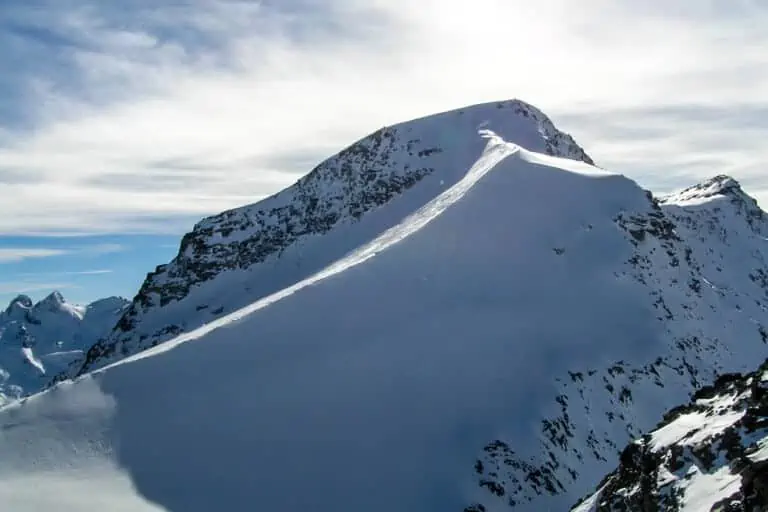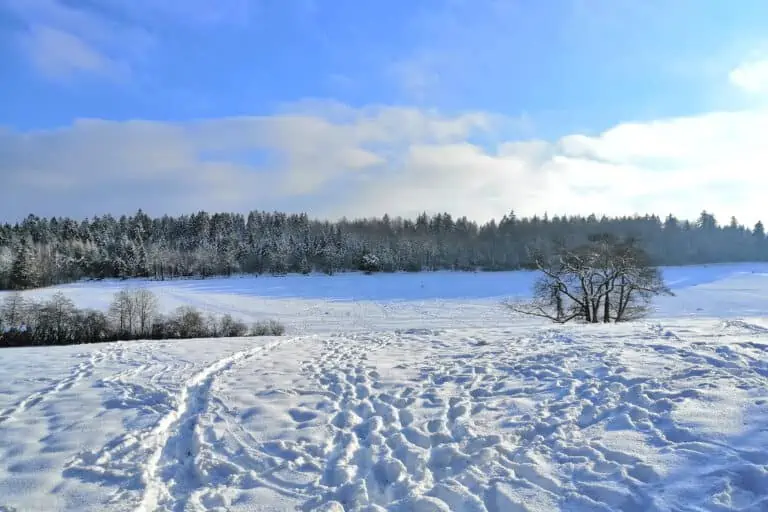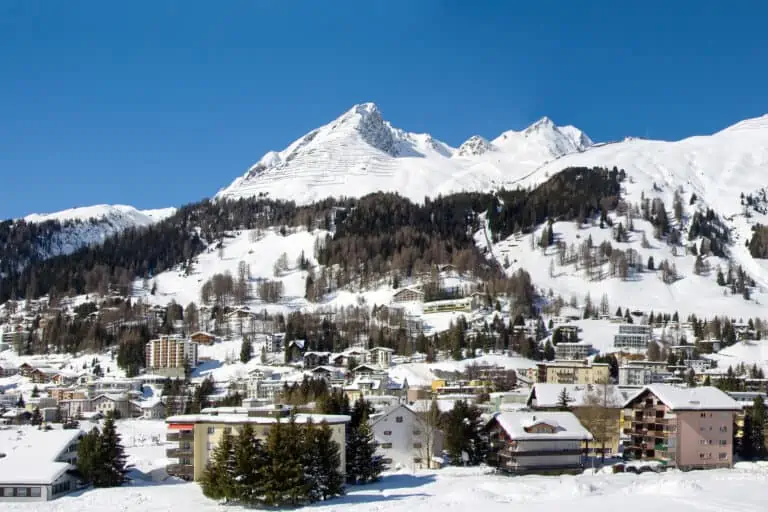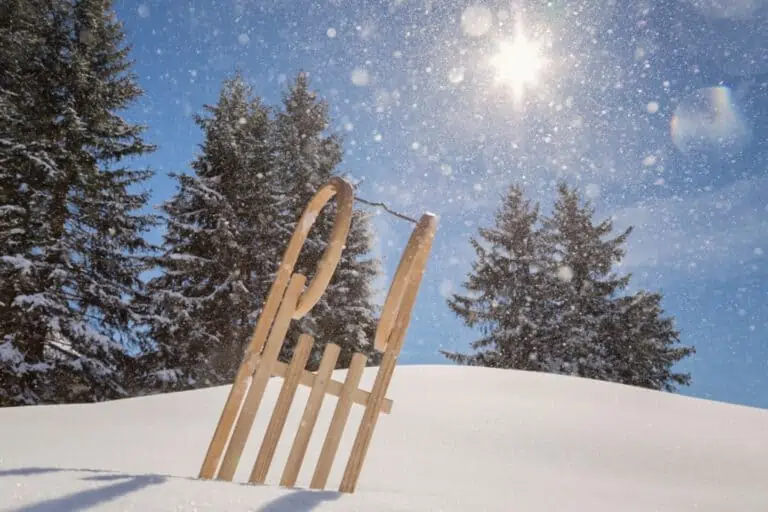Snow parks
There are many snow parks in Switzerland. If you want to have a day full of different snow experiences, such parks are the place to go. Activities are different at each location. They can include sledding, snowtubing, zip lining, and so on.
Snow activities are available on nearly all higher mountain tops. The ones below have some of Switzerland’s most famous winter snow parks:
Sledding or sledging in Switzerland
What’s sledding or sledging?
Sledding is also called sledging or (winter) tobogganing. It’s sliding down a snowy hill on a one- or two-person seat with ski-like sliders, mostly made of wood. This is great fun for the entire family.
How to sled in Switzerland
Sledding in Switzerland can be done in several ways:
- Do it yourself: buy or rent a sled and find an easy slope that you can climb several times. Check if it’s a safe place and make sure the slope has plenty of room to come down without harming other people.
- Visit a mountain snow park and enjoy a full day of sledding and other winter activities. You can often rent sleds and other gear on the spot.
- Use a groomed, long sled run. You can often rent your sled on the spot and hand it in at the end. There are even illuminated toboggan runs for a romantic evening ride.
Famous Swiss sled runs
Some of Switzerland’s most famous sled runs are:
- Preda-Bergün in the Albula Valley in Graubünden. This run has a 440 m descent over 6 km, between the villages of Preda and Bergün in the Albula valley. The track is suitable for families and children.
- Faulhorn-Bussalp-Grindelwald in the Jungfrau Region. This run, also called “Big Pintenfritz” in German, is famous for many reasons. It has beautiful views of snowy mountains such as the Eiger and the Wetterhorn. With a 1400 m descent over 15 km, it’s a very long and varied route. You’ll first have to use a groomed winter hiking trail to reach the mountain top Faulhorn. This hike starts at the top station of the Grindelwald-First cable car.
- Fiescheralp-Lax in the Upper Rhone Valley. This safe run offers 11 km of sledding fun with a 1050 m descent. First up are views of the Matterhorn in the distance. Then you’ll enter a forest.
- Col de La Croix-Les Diablerets in the Valais. This 7 km long zig-zagging run starts at Col de la Croix, to be reached by the “Diablerets Express” gondola. After a descent of 560 meters you’ll end in the village Les Diablerets.
Child-friendly Swiss sled runs
Examples of easy, child-friendly options are:
- Allmendhubel in the Jungfrau Region. A family-friendly run winds its way from Allmendhubel through the Blumental valley to Mürren. It ends at the Allmendhubel funicular valley station.
- Fräkmüntegg in the Lake Lucerne region. This gentle 5 km ride can be made from the mid-station of Pilatus.
- Schatzalp above Davos. A wide 3 km sled trail runs through romantic forests from Schatzalp to Davos.
Adventurous Swiss sled runs
Demanding sled routes include:
- Fronalpstock above Stoos in Central Switzerland. This thrilling 440m descent over 2 kilometers has magnificent views of the region.
- Muottas Muragl in the Upper Engadine. Here’s a speedy 4 km run with a 700 m descent and lots of hairpin curves. It’s not suitable for children or beginners. You’ll first enjoy great views over the Engadine mountains and then enter a pine forest.
Sledding safety tips
Always be careful when sledding:
- Pick a run or slope that’s not too demanding. You should feel comfortable with its difficulty level. Don’t overestimate your skills.
- You can reach high speeds while sledding. Lean backwards to reduce your speed. This puts more pressure on the sliders. You can also push your feet into the snow. This helps you to reduce speed, or to come to a full stop.
- Steering a sledge is hard. You can steer a bit by leaning toward one side, and by using your feet. Adjust your speed or pick an easy route if you’re not experienced.
- Always keep other people in mind. Keep your distance and adjust your speed to avoid crashes.
- Use a helmet, ski goggles and other appropriate winter gear.
- If you’re skiing with small children, put them in front of you on the sled. Use gentle, child-friendly slopes only.
Alternatives to sledding: snowtubing, snowbikes and more
Besides sledding, there are more ways to enjoy the Swiss slopes. Some examples:
- Snowtubes are round, inflatable cushions in which you can comfortably lie down on your back. There’s a huge “Toboganning Park” in Leysin (canton of Vaud), offering lots of runs in ice channels. They’re of varying difficulty. Other examples of snowtubing locations are Trübsee under Titlis (Central Switzerland), Maloja (Upper Engadine) and Saas-Almagell (Saas Valley).
- Airboards are large inflatable cushions on which you can slide down in several poses. Airboard runs are available at several locations. A thrilling one can be found at Fronalpstock (Central Switzerland).
- Snowbikes are bikes with a large ski at the bottom instead of wheels. You can use them at Hannigalp in the Matter Valley for example.
- Snowmobiles are electrically driven motors with thick rubber bands. You can make guided tours or rent them yourself in the snowpark under Titlis. They’re kid-friendly too. A special children’s snowmobile park is available at the Brunni ski lift (between Lake Zurich and Lake Lucerne). More options can be found here.
- The “Zipflbob” is a plastic sled with a handle, used for steering and turning. It’s available at a few places, including Gamplüt (St. Gallen, North-East Switzerland).
- The “Bobsla” is an electric snow cart, available at the Kerenzerberg above Filzbach (Glarus, North-East Switzerland).
- Switzerland has many alpine coasters or mountain coasters. In German, they’re often called ‘Rodelbahn’ or ‘Bob-Bahn’. You’ll slide down over a fixed metal downhill track on a one- or two-person seat. Most are open in summer only, but Switzerland’s longest coaster is available in winter too. The Pradaschier ride (Arosa-Lenzerheide, Graubünden) offers a 480 m descent and over 30 curves.
- Tourists can made a guided ride down in the Olympic bob run near St. Moritz.
Ice skating
Ice skating on indoor and outdoor rinks
You can enjoy ice skating at many indoor and outdoor rinks in Swiss towns and cities. Skates can often be rented on the spot.
Ice skating on frozen Swiss lakes
Ice skating in Swiss nature is another option. It’s possible at several lakes and prepared natural rinks.
Weather conditions have to be favorable: temperatures need to be low and there shouldn’t be too much snow. This allows the water surface to turn into a thick and smooth layer of ice. Chances are better at higher altitude, where temperatures are lower.
Examples of Swiss lakes on which ice skating is sometimes possible::
- St. Moritzersee (“Lej da san Murezzan” in Rheto-Romanic; 1768 m / 5800 ft) in the Upper Engadine
- Oeschinensee (1578 m / 5177 ft) in the Kander Valley
- Seealpsee (1143 m / 3750 ft) in the canton of Appenzell in North-East Switzerland
- Schwarzsee (“Lac Noir” in French; 1049 m / 3441 ft) in the canton of Freiburg in South-West Switzerland
- Sihlsee (889 m / 2916 ft) in the canton of Schwyz in North-East Switzerland
Ice skating on natural ice roads
A few natural ice skating roads can be found in the canton of Graubünden. Their availability too depends on weather conditions.
Ice skating in nature: warning
Only use natural lakes and rinks if they’re officially open for ice skating. Trying on ice that’s too thin is very dangerous.
Cross-country skiing
What is cross-country skiing?
Cross-country skiing is very different from quickly skiing downhill. You’ll slide on skis using a walking-like motion. The snow terrain is mostly even. There can be modest height differences, meaning you’ll have to climb a bit or gently slide down.
Cross-country skis are different from regular skis. They’re long and lightweight. Only the tip of the shoe is attached to the ski. Cross-country skis can be rented at many locations in Switzerland
How to learn cross-country skiing
Cross-country skiing can be learned quickly. But it’s important to use the right technique from the start. So prepare yourself with videos or take a beginners’ class in Switzerland. Lessons are offered by many ski schools.
You can also book a guided tour. The guide will teach you basic techniques and then take you out on a cross-country run for several hours.
Although cross-country skiing looks easy, it requires stamina and good physical shape.
How to recognize cross-country skiing trails
Swiss cross-country trails are indicated by green signs, depicting a white cross-country skiing figure.
Where to enjoy cross-country skiing in Switzerland
Switzerland has a huge network of groomed cross-country trails. Broad valleys are perfect for cross-country skiing. A few examples are:
- the Lower and Upper Engadine (Graubünden)
- the Upper Rhone Valley (Valais)
- the area around Davos and Klosters (Graubünden)
- the Kander Valley (Bernese Oberland)
Husky activities in Switzerland
Husky walks or sleigh rides are great for animal lovers. Sometimes you can even enjoy a full day with the dogs, learning all about them. Booking in advance is usually required.
- In Col des Mosses (South-West Switzerland) you can make a ride over well-groomed trails. An annual dogsledding competition in March takes place here too.
- Les Bois in the canton of Jura is home to “Jura Escapades”. You can learn all about huskies here and follow a sled dog course.
- In the Fribourg area in (South-West Switzerland), you can learn how to ride the sled. Of course, you’re guided by a professional.
- The “Team Nature” company in St. Cergue (South-West Switzerland) offers several dog winter activities.
- Winter hikes with husky dogs can be made near Crans-Montana (Valais).
- Dog sled tours are available from the Whitepod Eco Luxury Hotel in Les Cerniers (Valais).
- Dog sled rides are among the many activities at Glacier 3000.
- The “Husky Stuff” company in Alt St. Johann in St. Gallen (North-East Switzerland) offers half-day dog sled tours. But you can also stay with them for a full week and really bond with the dogs.
- The “Hüttenhotel / Husky Lodge” is located in the Muotathal in the canton of Schwyz (Central Switzerland). It’s home to a pack of about 30 huskies.
- A dog sledding race (“Schlittenhunderennen” in German) takes place each February in Gadmen near Innertkirchen (Bernese Oberland).
- Another tip for dog lovers is Barryland in Martigny (Valais). You can learn all about the famous St. Bernard dogs and watch them up close.
Winter horse-sleigh rides
Horse-sleigh rides
Enjoying a snowy Swiss valley from a horse-drawn sleigh is very romantic. Advance booking is usually required.
- One of the best places is the Roseg Valley near Pontresina (Upper Engadine). Several rides a day are scheduled. The route runs between the Pontresina railway station and Hotel Roseg in the valley.
- Two companies organize sleigh rides into the beautiful Fex Valley. It’s north of the romantic village Sils (Upper Engadine).
- Several horse-carriage rides are available from Rigi Kaltbad, half-way up Mount Rigi.
- You can make a horse-sleigh ride organized by “Kutscherei Reichenbach” in the Gstaad region.
- There are several horse-carriage routes near Davos and Klosters in Graubünden.
- Arosa is a great winter sports resort. The many activities include horse-sleigh rides.
- The “Nussbaumer” company offers winter rides at Raten in the canton of Zug (between Lake Lucerne and Lake Zurich).
- Winter rides can be made from the village of Urnäsch in the canton of Appenzell (North-East Switzerland).
Horse-sleigh rides with fondue
At some routes, you can even enjoy a fondue meal in the carriage:
- Enjoy Swiss fondue during a ride from Lenk in the Simmen Valley.
- “Kutschenfahrten Scherrer” is located in Dietfurt (between Lake Zurich and Lake Lucerne). They offer fondue trips in cosy warm carriages.
Winter and snow adventures
If you like adventurous winter activities in Switzerland, consider the below suggestions. Always book a safe trip with professional guides.
- Helicopter sightseeing rides can be made on many Swiss locations. The huge CO2 footprint can be compensated in order to have a green ride.
- Book an ice climbing tour. Check if prior experience is required.
- Paragliding is a thrilling and scenic activity. It’s available in winter too, near many mountain resorts. Local companies organize the flights.
- Climb the via ferrata near Saas-Fee. Most via ferrata routes are accessible in summer only, but this one is open in winter too.
- Try winter kayaking at Lake Brienz (Bernese Oberland).
- Go snow kiting near Franches-Montagnes in the Jura mountains (West-Switzerland).
Find all adventure excursions in Switzerland here.
Winter festivals
There are many winter festivals and events in Switzerland. Below are a few famous ones.
- There’s a spectacular hot-air balloon festival each last week of January. It’s held in Chateau d’Oex (South-West Switzerland). Visitors can make a balloon ride too.
- In late January, you can visit the World Snow Festival in Grindelwald. You’ll see beautiful ice sculptures, made by international artists. There’s a different theme each year.
- Geneva is home to a large December festival. It’s called “l’Escalade”. You can enjoy music, cannon fires, folklore demonstrations, and food.
More practical info for your winter trip

Winter activities

Winter weather and best time to visit

Winter towns
Other websites of interest
- www.schweizmobil.ch: sled runs in Switzerland
- www.schweizmobil.ch: cross-country skiing tracks in Switzerland
- www.myswitzerland.com: Swiss winter events and festivals
- www.helis.com: reliable Swiss helicopter companies
